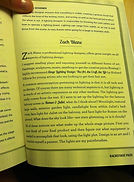So You Wanna Be A Superstar
contributing author
Wrote Lighting Design Section For Paperback Book Geared Toward Young Professionals
Zach Blane, a professional lighting designer, offers great insight on all aspects of lighting design:
I suggest reading plays and exposing yourself to different forms of art. Painting, sculptures, music, anything to get the creative juices flowing!
A common misconception pertaining to lighting is that it is all tech and no design. Of course there are many technical aspects to it, but lighting is as much of an artistic expression as any other medium. The lighting generally comes from the text. If I were to set up the lighting for the famous balcony scene in Romeo & Juliet, what do I think about? Moonlight, textural large walls, exterior garden light, candlelight from within Juliet's bedroom, face light for Juliet on the balcony, and face light for Romeo on the ground.
What does the sky look like - are stars glistening, or is it cloudy?
All of these notions are what make up the whole stage picture. First you must think of your final product and then figure out what equipment is needed to accomplish that look, using the light plot.
Design is an art and I consider myself a painter. The lights are my paintbrushes.
Once the stage picture is set, a lighting designer must finesse the "internal" cues. For example, how do I subconsciously pull to the balcony after Romeo has climbed it, without the audience physically noticing a change?
Lighting design expresses the psychology of the piece. It is the foundation in which the show is presented to an audience. It can hide things you don't want them to see and highlight things you do.
Designers are like magicians, taking the spectator on a journey by guiding them with a sleight of hand.


